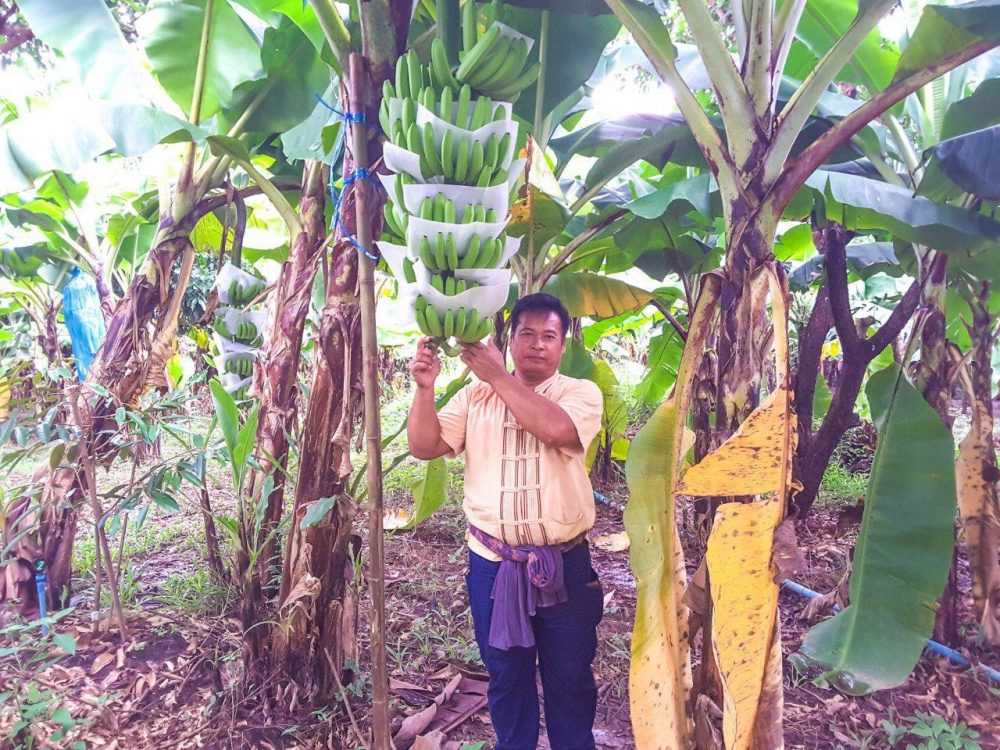UBON RATCHATHANI – On the banks of the Mekong river, the Bru people of Ban Ta Mui in the picturesque Pha Taem National Park in Khong Jiam district are turning en masse to cavendish banana (gluay hom) cultivation in a bid for economic survival.
Chinese hydroelectric dam construction may have removed the economic viability of fishing for this community, but Chinese demand for cavendish bananas has thrown them a new economic lifeline.
“It was necessary to give up fishing and turn to farming because year after year we were catching fewer and fewer fish,” explains Somchai Khayankan who started growing bananas last year. A fishermen all his life, 15 years ago he made the drastic decision to switch to fruit farming instead.

A riverside sign declares this community as an OTOP Tourism Village. The Bru people migrated from the east to the area where the Mun river meets the Mekhong basin many generations ago. They were known to be excellent fishers, and in many Bru homes fishing equipment has pride of place, though these days they may not be in good working order.
Mr. Somchai’s verbal account of decreasing fish stocks during this time period coincides with the commissioning of numerous hydroelectric dams in the Mekong River basin. According to a study by the Stockholm Environment Institute, infrastructure development along the Mekong River is damaging the viability of the basin’s fisheries.
Mr. Somchai experimented with different cash crops but these days he almost exclusively grows bananas for the Chinese market.
“For my pilot plot of five rai I invested a total of 30,000 baht,” Mr. Somchai recounts. “Most of that was for laying the irrigation system, buying the first stock of banana trees, and fertilizer.” He adds that fertilizer was and still is the least of his costs because he either makes or locally acquires organic compost.
All of Mr. Somchai’s produce is purchased by Agrofresh (Thailand) Co., Ltd., a subsidiary of Malaysian fruit giant Agrofresh International Sdn Bhd. The multinational fruit exporter counts China among its key markets.

Apart from Mr. Somchai’s 37-rai (about 14 acres) plantation, Khong Jiam district contains ten other cavendish banana plantations spread over 70 rai. Together they send around 32 tons per month to China.
Economic development in China has led to a rise in consumption of all fruit as Chinese consumers become more affluent and health-conscious. Over the past decade China’s appetite for bananas has doubled to 10 kg per capita, making China the second largest market in the world for bananas after India.
Chinese demand speaks for most of the cavendish bananas grown in Thailand, according to Araya Yoodee, representative of the of the Lower Isaan Cavendish Banana Farmers Association. “China easily consumes over 600,000 tons of cavendish bananas per year,” she says.
Ms. Araya expects cavendish banana cultivation in lower Isaan to expand to 200 rai by 2019, thanks in large part to their proximity to Ubon Ratchathani’s Chong Mek border crossing into Laos, which gives way to routes into China via Vietnam. By comparison, the Department of Agriculture’s most recent statistics show that there are 33,330 rai of cavendish banana cultivation across Thailand as of 2014.
Across the Mekong, the Lao people have grown increasingly wary of Chinese banana plantations for their excessive use of pesticides that has led to droves of local farmers falling ill. Last year, the Laos government reacted by suspending the operations of 18 Chinese-backed banana farms, according to a report by Radio Free Asia.

As befits a people renowned for fishing prowess, it is still common to see traditional fishing equipment on proud ceremonial display in many Bru households today. But today several Bru people communities in the area have switched to banana farming. Araya Yoodee (third from left, front row) and Somchai Khayankan (second from right) show off their prize local produce together with friends and family.
Romanticism gives way to poetic pragmatism in the village OTOP shop. By damming the Mekong river to meet the electrical demands of its industrial revolution, China has effectively put paid to generations-old fishing traditions downstream in Isaan. Yet Chinese economic growth — and taste for cavendish bananas — is what drives the planting in Ban Ta Mui.
Cavendish banana products are on the ascendant in the village, despite having been cultivated there for just a year. In this Bru community at least, the cavendish banana has superseded fishing tackle.
Reporting and photography by Panupop Yuttakij. Edited and translated by The Isaan Record.




